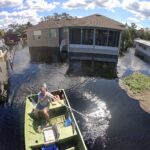This article is part of a sponsored series by Right Street.
In recent months the dynamic markings for voices asserting the insurance industry is not up to challenges posed by climate change have gone from mezzo-piano to mezzo-forte. In his endorsement of a proposal by Representative Adam Schiff (D-Calif.) to create a federal reinsurance facility, Consumer Watchdog founder Harvey Rosenfield declared that “it is increasingly clear that the insurance industry is unwilling or unable to serve the needs of consumers….and for that reason government intervention is necessary.” Former California Insurance Commissioner Dave Jones opined that “we’re steadily marching toward an uninsurable future, not just in California but throughout the United States.” The anti-fossil fuel organization Insure our Future maintains that insurers contribute to climate change. Insure our Future is backed by the Connecticut Citizens Action Group, whose mission statement is to “actively engage the residents of Connecticut in altering the relations of power in order to bring about environmental, economic, and social justice.”
The “uninsurable future” crowd is mainly on the left, but needn’t be. Our research has shown that the severity of natural catastrophes–especially flooding–has increased, even after normalizing for an increase in the built environment. And hurricanes, hailstorms, tornadoes, floods are non-partisan. As they get more intense, they’ll destroy Republican homes with the same fury as they strike Democratic homes.
Analysis to determine whether or not the future is uninsurable presupposes that we know what the future will hold. We don’t. But there is data to support the contention that, whatever the future brings, it does not constitute an existential threat to the insurance industry.
Insurance Capital and Alternative Capital
The property and casualty insurance industry had $2.7 trillion in assets at year-end 2023. It incurred $627 billion in losses in the year. In addition to primary insurance capital, the reinsurance industry has an additional $670 billion of capital, $108 billion of which is “alternative” capital in the form of insurance-linked securities, mainly catastrophe bonds. It is important to note that the volume of alternative capital backing insurance virtually doubled from a decade ago. This means that third party investors and asset managers, seeking diversification in their investment holdings uncorrelated with capital market swings, are increasingly comfortable with insurance risk–running to it, not away from it. And importantly, whereas a decade ago liability risk and cyber risk were considered not fair game for ILS products because there were no models to inform pricing, today there are cat bonds for all manner of risks once considered uninsurable — liability risk, cyber risk, nuclear risk and wildfire risk. To be sure, as insurers obtain data to inform projections of losses, they are willing to insure risks that were once considered “uninsurable.” Not many decades ago, insurers would not touch earthquake risk because earthquakes were considered unpredictable “acts of God.” Today earthquake insurance and reinsurance and ILS products actively take on earthquake risk.
Historically, when insurers got a black eye from unexpected catastrophes, such as the great liability crisis of the 1980s, the 9/11 terrorist attacks, the $81 billion (adjusted for inflation) in hurricane losses in 2005, the year of hurricanes Katrina, Rita and Wilma (KRW), insurance markets were disrupted only temporarily, and insurers responded creatively. New third party capital supported the formation of liability insurers in the 1980s. In the wake of 9/11 and KRW new reinsurers with clean balance sheets were formed. These responses to shocks for insurers demonstrate that insurers have been resilient in the face of challenge. Resilience means being able to bounce back. That’s what insurers, financial first responders, do. It’s their business.
I’m From the Government, and I’m Not Here to Help
The unsupported assertion that the insurance industry is not up to the task of insuring risk exacerbated by climate change may be a stalking horse for efforts to introduce federal insurance and reinsurance entities, as proposed by Representative Schiff’s INSURE Act. This seeks to create a federal catastrophe reinsurance entity, backed by the U.S. $5.4 trillion balance sheet and $50 billion in startup capital. The federal government has already botched its management of two insurance programs – federal flood insurance and crop insurance. Instead of burdening taxpayers to whom risk would be socialized, if the ILS market were to attract just five percent of the $35 trillion in retirement assets, adding uncorrelated risk to investment portfolios, that would bring another $1.8 trillion to the P&C balance sheet. Private markets can handle the challenge. Let not the feds stand in the way.
Topics Trends
Was this article valuable?
Here are more articles you may enjoy.



 US House Bill Aims to End Private Flood Insurance Coverage Penalty
US House Bill Aims to End Private Flood Insurance Coverage Penalty  Trump Administration Turning to Private Firms in Cyber Offensive
Trump Administration Turning to Private Firms in Cyber Offensive  Hacking Group ‘ShinyHunters’ Claims Theft of Data From Users of Pornhub
Hacking Group ‘ShinyHunters’ Claims Theft of Data From Users of Pornhub  WTW to Acquire Newfront in Deal Worth Up to $1.3B
WTW to Acquire Newfront in Deal Worth Up to $1.3B 


